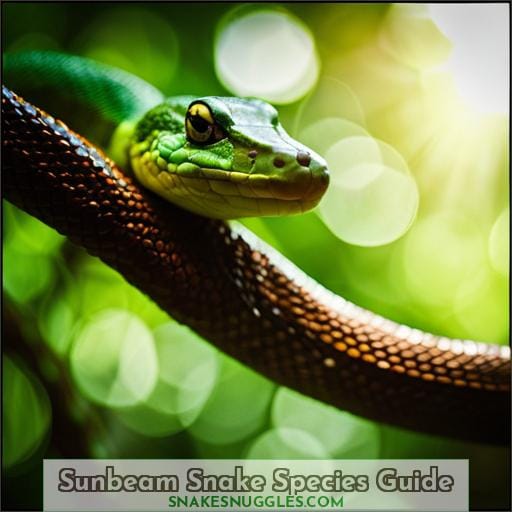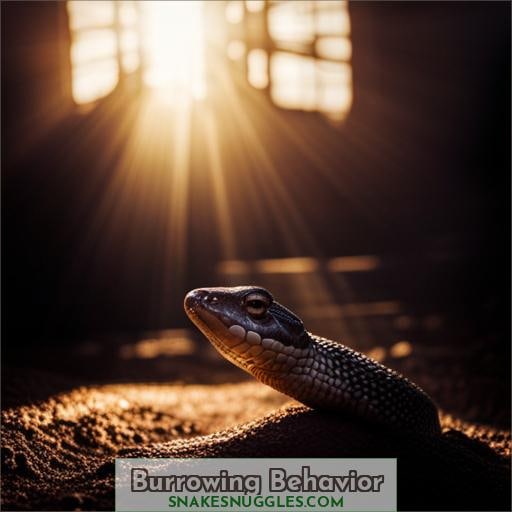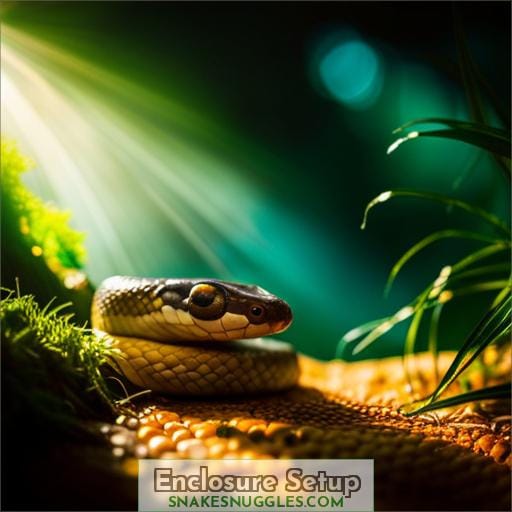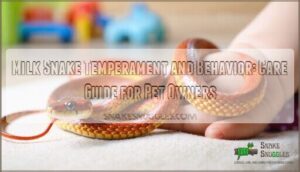This site is supported by our readers. We may earn a commission, at no cost to you, if you purchase through links.
 Are you looking for a unique pet snake? Sunbeam snakes are an exotic species from Southeast Asia that could be the perfect addition to your reptile family. Their iridescent scales make them stand out among other species, and their nocturnal habits give them an air of mystery.
Are you looking for a unique pet snake? Sunbeam snakes are an exotic species from Southeast Asia that could be the perfect addition to your reptile family. Their iridescent scales make them stand out among other species, and their nocturnal habits give them an air of mystery.
Though they’re not venomous, these snakes have specific care requirements that must be met in order for your pet to live a long and healthy life.
Table Of Contents
Key Takeaways
- Sunbeam snakes are unique pet options from Southeast Asia with iridescent scales and nocturnal behavior.
- There are two species of sunbeam snakes, Xenopeltis unicolor and X. hainanensis, known for their iridescent black/brown scales and boa-like shape.
- Sunbeam snakes have specific care needs, including the proper temperature range, humidity levels, and enclosure setup with hiding spots.
- Captive-bred sunbeam snakes are generally healthier than wild-caught ones, and conservation efforts are being made to protect their threatened populations.
Sunbeam Snake Species Guide
If you’re experienced in reptile keeping, the two species of sunbeam snakes from Southeast Asia and India may be a great choice for you. They have an iridescent black or brown coloration and are known to vibrate their tails when alarmed.
With proper care requirements such as temperature needs, substrate selection, handling tips, and disease prevention, these reptiles can make beautiful additions to any collection. Sunbeam snakes need well-ventilated enclosures with temperatures ranging from 80°F – 90°F during the daytime hours.
These temperatures should be maintained by heating systems such as under-tank heaters or ceramic bulbs.
A moist soil bedding is also necessary for them since it helps maintain humidity levels above 75%. Captive-bred specimens available through the pet trade are generally healthier than wild-caught ones, so always go with captive-bred whenever possible.
As far as handling goes, it’s better not to handle them too often because stress could result in significantly increased mortality rates if not done properly.
All in all, these unique creatures will bring beauty and add interest to your collection while being relatively easy to maintain once proper conditions are provided!
Appearance and Colors
Moving on from their species overview, let’s take a closer look at the unique appearance and colors of Sunbeam snakes. These reptiles have an iridescent black or brown upper body coloration with white underneath.
The scales are glossy in texture, often reflecting hues of metallic colors when light reflects off them, creating what appears to be a rainbow shine.
In addition, they have small depressed heads and cylindrical bodies that average 1 meter (3ft) long but can reach up to 1.
Iridescent scales are one of its many defining features, along with its boa-like shape and size, making it stand out among other common household pets available today!
Burrowing Behavior
You’ll be amazed by the sunbeam snake’s burrowing behavior, as they are capable of creating complex tunnels in a short amount of time.
Most commonly found in Southeast Asia and India, Xenopeltis unicolor and X. hainanensis create intricate underground networks to regulate temperature, provide shelter from predators, and find prey for sustenance.
In order to successfully keep this species in captivity, it is important that these needs are met with an enclosure setup providing deep substrate such as soil-like material like coconut fiber or moss—this level should reach at least 8 inches deep!
Additionally, some extra hiding spots should be provided along with constant access to shallow water dishes. To avoid stressing your pet out, it must also have ample space so that its environment can more closely resemble their natural habitat.
This allows them the opportunity to display their remarkable burrowing behaviors while maintaining proper temperature regulation through layering different substrates of varying depth within the enclosure.
Although not recommended for beginners due to high mortality rates associated with improper husbandry practices, experienced keepers can appreciate Xenopeltus intermedius’s unique characteristics, including its primitive features, while supporting all their shelter requirements necessary for successful captivity leading up to a long, happy life full of exploration!
Enclosure Setup
Setting up an enclosure for a sunbeam snake is an important task for experienced keepers. An appropriate setup will provide the right temperature, humidity, and size that are essential to their health and wellbeing.
- Provide a 32-quart plastic tub with soil-like substrate as the pet enclosure.
- Place in warmth using an under tank heater or thermostat set at 80°F ambient temperature.
- Maintain high humidity (75–100%) by misting regularly and keeping water dishes filled throughout the day so they can stay hydrated while shedding their skin periodically during growth spurts.
- Make sure there’s plenty of hiding places such as rocks, logs, or plants to make your sunbeam snake feel secure in its new home environment.
- Monitor your pet’s behavior closely – if it appears stressed, reduce handling time significantly until further notice from veterinarian specialists.
Taking good care of this primitive reptile will guarantee a longer lifespan and healthier development over time, providing you with pleasant memories along its journey!
Feeding
Experience the thrill of feeding your beautiful sunbeam snake a variety of nutritious meals. Sunbeam snakes require an adjusted diet to meet their nutritional needs, and meal preparation varies based on whether you choose live or pre-killed prey.
Diet variation is important for pet care as it keeps them healthy in captivity. Live prey should be adapted to the habitat needs, while smaller-sized pre-killed animals can provide adequate nutrition without stressing out your snake too much.
Meal sizes will depend upon the size and age of your sunbeam snake; however, avoid offering food larger than its head as this could cause choking or regurgitation problems.
Health Issues
When it comes to taking care of a Sunbeam Snake, health issues should be the utmost priority. While these snakes are generally hardy reptiles, they can still develop various illnesses if proper handling and maintenance isn’t provided.
Here’s what you need to know for keeping your snake healthy:
- Disease Prevention: To minimize the risk of disease transmission, practice good hygiene when handling your snake or cleaning its enclosure.
- Diet Concerns: Feeding a balanced diet is important for maintaining their skeletal structure and overall health. Fresh food items, such as mice, should always be offered in moderation since overfeeding can lead to obesity or other medical problems.
- Veterinary Care: Regular visits by an experienced reptile veterinarian will help identify any potential issues before they become more serious.
Finally, some additional tips include providing adequate hiding spots throughout the enclosure, which helps reduce stress. Also, make sure to have regular spot-cleaning sessions with warm water and mild detergent (not bleach!) for sanitation purposes.
Additionally, weekly mistings should be done at least twice per week, depending on the humidity requirements specific to the species and geographic region where the snake is kept.
All these steps combined will ensure that your pet Sunbeam Snake stays fit and happy!
Finding and Picking a Sunbeam Snake
Carefully research the unique needs of these primitive creatures before deciding to take on a Sunbeam Snake as a pet. The species facts, genetics, shedding, and food sources should all be considered when selecting your animal.
A healthy specimen with an ideal appearance is key in order to ensure successful breeding and relocation if needed.
Species Facts:
- Xenopeltis unicolor
- Primitive family
Genetics: Yes
Shedding
Food Sources: Snakes, Frogs, etc.
Breeding: Possible
Relocation: Ideal
Appearance
Handling: Minimal
Facts
You’ll be amazed to learn that sunbeam snakes have a maximum size of 1.2 meters and an average lifespan of 10 years! They are found in Southeast Asia, India, and Indonesia and prefer moist terrain with lowland to lower montane forests or scrublands.
Sunbeam snakes feed on small mammals, lizards, frogs, and birds, but captive handling is not recommended as stress can lead to mortality.
Here’s a quick care guide: their habitat needs high humidity (75-100%) at 80°F ambient temperature. They have hind legs which help them burrow into mud or decaying vegetation. Their food preferences include rodents and amphibians.
Their breeding habits involve laying 6-17 eggs in clutches, with juveniles having white collars around the neck. The population status is stable yet decreasing due to deforestation and fragmentation of habitats.
With proper enclosure setup and minimal handling, these primitive species could make for amazing pets – you won’t regret it!
History and Evolution
Discover the ancient history and evolution of this iridescent species as you learn about Xenopeltis unicolor. Sunbeam snakes belong to a primitive family, the Xenopeltidae, that is believed to have evolved over 50 million years ago in Southeast Asia.
Climate change and habitat destruction caused by humans have resulted in population decline for these snakes all across their range. Genetic diversity studies suggest that wild-caught specimens are less diverse than captive-bred ones, highlighting the need for more scientific research into snake habitats and dispersal mechanisms.
Despite the implementation of captive breeding programs around the world, many sunbeam snake populations continue to be threatened due to ongoing habitat loss or degradation from human activities such as deforestation or agricultural land development.
It is important, then, that we protect what remains of their natural environment so they can survive long into future generations!
Population & Conservation Status
As an experienced keeper, it’s important to be aware of the population and conservation status of sunbeam snakes. Habitat loss due to expanding human populations is one major threat they face, as well as climate change and wildlife trade for pet owners or traditional medicine.
Captive breeding efforts have been successful in helping sustain their numbers. However, wild populations are still decreasing due to rice paddies taking over previously suitable habitats. Sunbeam snakes can still be found throughout Southeast Asia, but locating them in the wild can prove difficult because of their nocturnal behavior.
Conservationists are working hard on protecting these non-venomous reptiles from further decline by establishing reserves that provide suitable habitat for them. They are also educating locals about natural resources management programs, such as limiting hunting and fishing activities near sunbeam snake areas.
As a result, more people appreciate this unique species’ importance, which helps ensure its survival into future generations with proper care from experienced keepers like you!
Frequently Asked Questions (FAQs)
What is the best type of substrate to use for a sunbeam snake enclosure?
Experience a remarkable reptile’s habitat with the best substrate for sunbeam snakes: a soil-like material. Create an optimal environment, perfect for their burrowing nature and providing warmth and humidity.
How often should a sunbeam snake be fed?
Sunbeam snakes should be fed every 5-7 days, depending on their age and size. Symbolically represent your snake’s health by feeding them regularly to ensure they’re well-nourished and happy! Provide a variety of prey items such as frogs, lizards, small mammals, or birds in appropriate sizes for the individual snake.
What should I do if my sunbeam snake stops eating?
If your snake stops eating, try offering different types of food or smaller portions. Monitor the temperature and humidity levels in its enclosure as they can affect appetite. Seek veterinary advice if necessary to rule out any medical issues and ensure your pet is healthy.
Are sunbeam snakes endangered?
No, sunbeam snakes are not endangered. Although their population has decreased due to habitat destruction and hunting for food in some parts of Southeast Asia, they remain common throughout most of their range.
They have been successfully bred in captivity, and these specimens can be found at pet stores or reptile expositions around the world.
Are sunbeam snakes social animals?
No, sunbeam snakes are not social animals. They prefer to live alone and remain solitary unless breeding or when threatened by a predator.
Conclusion
No other snake on earth can compare to the majestic sunbeam snake. They not only boast iridescent black and brown scales but also have primitive features and burrowing behavior, making them a truly unique species.
With the right enclosure setup, feeding regimen, and healthcare, these snakes can live up to 10 years in captivity. However, they are not suitable for beginners due to their specific needs and must be handled with care.
Finding a sunbeam snake can be a challenge as they are not widely available. But with the right research and dedication, you can find a healthy specimen. The sunbeam snake is sure to enchant you for years to come, with its fascinating evolution and conservation status.
















